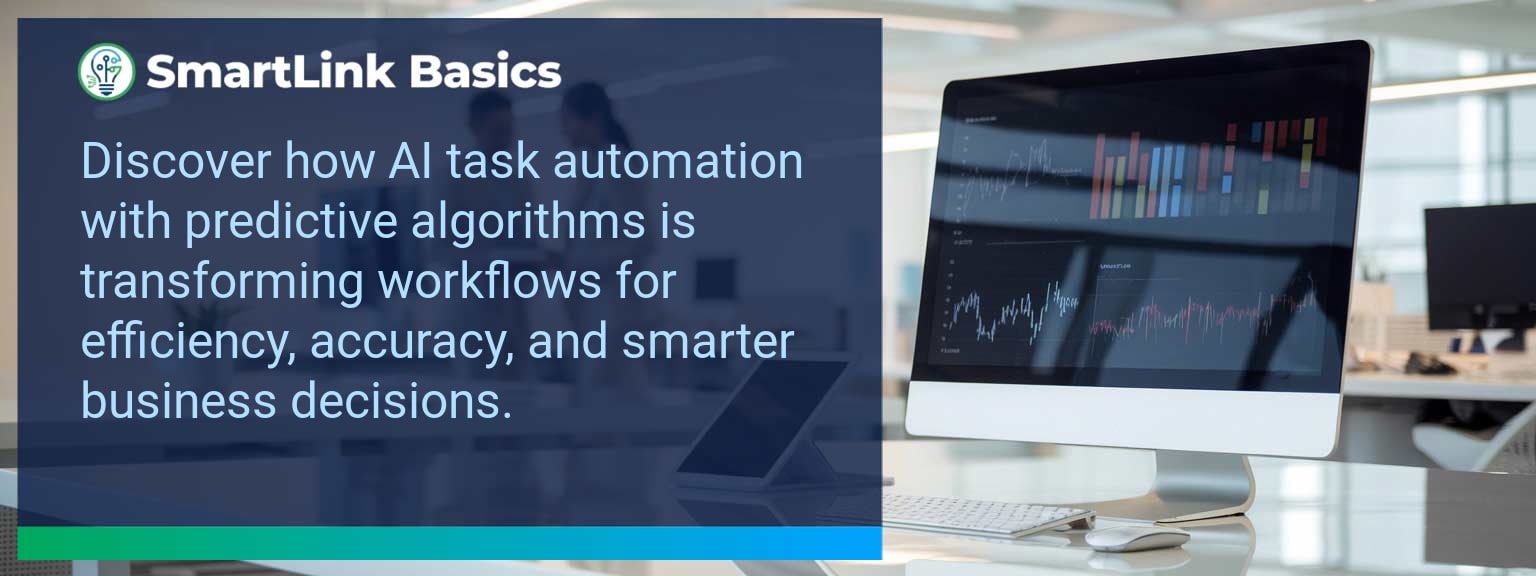Accuracy in decision-making now depends on the speed and intelligence of automated processes. Research from McKinsey shows that AI-driven automation can increase business productivity by up to 40%, making it a competitive imperative for sales organizations. At SmartLink Basics, we see AI task automation becoming a core enabler for leaders who want to compress sales cycles, improve forecasting precision, and reallocate human effort to higher-value activities. This article explains how predictive algorithms streamline workflows, where most revenue operations lose efficiency, and how you can quantify the gains. You’ll learn actionable techniques to redesign your process architecture, identify automation opportunities, and align intelligent systems with your team’s performance objectives.
- Integrate AI task automation to eliminate repetitive manual steps in workflows
- Use predictive algorithms to anticipate sales opportunities and resource needs
- Redesign processes around data-driven triggers, not static schedules
- Measure impact using both leading and lagging performance metrics
- Adopt emerging intelligent automation trends to maintain competitive advantage
What Changed and Why AI Task Automation Matters Now
AI task automation has moved from experimental pilots to mainstream adoption because predictive algorithms can now interpret vast transactional and behavioral data in near real time. For sales leaders, this means the shift from reactive operations to proactive decision-making. Machine learning models can recommend next-best actions, automate follow-up sequences, and dynamically adjust forecasts. For example, high-growth SaaS firms now use AI-driven signals to trigger territory reallocations automatically, cutting delay from weeks to hours. Leaders should focus on embedding these capabilities within CRM and workflow platforms to ensure consistency across teams.Redesigning the Revenue Operating System with AI Task Automation
Sales organizations that integrate AI task automation into their operational framework create a more responsive and measurable workflow. This redesign spans four core areas: ICP, Segmentation, and Targeting Predictive algorithms refine ideal customer profiles by analyzing closed-won data, improving targeting precision. Actionable insight: Feed updated ICP definitions directly into outbound sequences to ensure immediate alignment. Pipeline Architecture Automation tools can flag stalled deals or reassign aging opportunities to new owners. Actionable insight: Establish pipeline stage triggers in the CRM powered by AI scoring models. Plays and Messaging Content delivery becomes timing-sensitive with AI-driven insights predicting buyer readiness. Actionable insight: Automate persona-specific messages based on interaction data patterns. Operating Cadence AI-driven scheduling determines the optimal frequency for manager-rep coaching sessions. Actionable insight: Integrate cadence automation with team performance dashboards to keep activity levels consistent.Identifying Gaps In Traditional Processes
Legacy workflows often suffer from delays between signal detection and human response. Without AI task automation, follow-up actions depend on manual initiation, which increases the risk of lost opportunities. Predictive algorithms close this gap by initiating pre-defined plays the moment a trigger condition occurs. For example, an enterprise software vendor using traditional lead routing might take two days to reassign leads after rep turnover; automated routing based on predictive scoring can do it instantly. Map your high-friction process points, then identify which can be governed by intelligent systems.Leveraging Predictive Algorithms For Automation
The real value of predictive algorithms lies in their ability to anticipate needs before they surface. They transform raw event data into prescriptive recommendations, enabling automated execution. This combination reduces cognitive load on sales reps, freeing them to focus on relationship-building. For instance, an AI-enabled sales assistant might automatically draft personalized renewal emails when contract expiration risk factors are detected. Review your current engagement touchpoints to determine where predictions can trigger personalized, automated micro-actions.Measuring Efficiency And Performance Gains
Quantifying the impact of AI task automation ensures your investment delivers sustained ROI. Leaders should monitor a blend of leading, lagging, and quality metrics to capture the full picture of performance.| Category | Metric | Definition | Target |
|---|---|---|---|
| Leading | Automated Task Completion | % of sales tasks auto-processed via AI tools | 85%+ |
| Leading | Predictive Signal Utilization | % of AI-generated alerts acted upon in same day | 90%+ |
| Lagging | Cycle Time Reduction | Decrease in days from lead to closed deal | -20% within 6 months |
| Lagging | Revenue Per Rep | Average closed revenue per sales representative | +15% YoY |
| Quality | Automation Accuracy Rate | % of AI-automated actions executed without error | 98%+ |
| Quality | Rep Satisfaction Score | Survey rating on automation usefulness | ≥ 4.5/5 |
Emerging Trends In Intelligent Automation
The next evolution in AI task automation will integrate multi-modal inputs, allowing predictive algorithms to analyze voice, text, and behavioral data in a single model. Some organizations are exploring autonomous sales process agents that perform entire transactional segments without human intervention. Use trends like hyper-personalized outreach sequencing and AI-mediated buyer-seller scheduling to stay ahead. Review the expert insights from SmartLink Basics to align your automation roadmap with these developments.Get the 90-day plan, coaching rubric, and dashboard template to operationalize AI in your enablement program.









